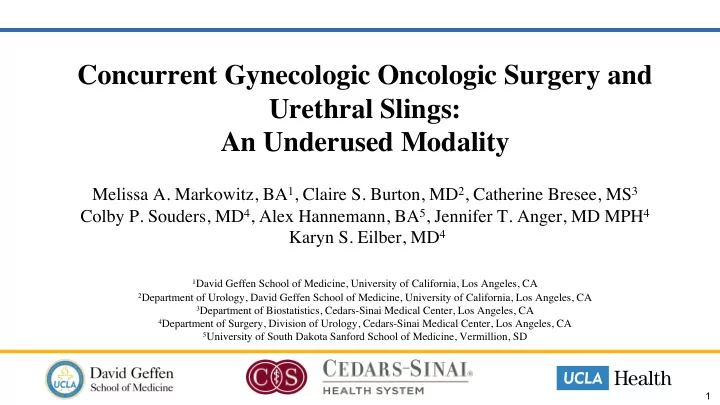

Concurrent Gynecologic Oncologic Surgery and Urethral Slings: An Underused Modality Melissa A. Markowitz, BA 1 , Claire S. Burton, MD 2 , Catherine Bresee, MS 3 Colby P. Souders, MD 4 , Alex Hannemann, BA 5 , Jennifer T. Anger, MD MPH 4 Karyn S. Eilber, MD 4 1 David Geffen School of Medicine, University of California, Los Angeles, CA 2 Department of Urology, David Geffen School of Medicine, University of California, Los Angeles, CA 3 Department of Biostatistics, Cedars-Sinai Medical Center, Los Angeles, CA 4 Department of Surgery, Division of Urology, Cedars-Sinai Medical Center, Los Angeles, CA 5 University of South Dakota Sanford School of Medicine, Vermillion, SD 1
Disclosures • None. 2
Introduction • Women with gynecologic malignancies have up to a 30% rate of concomitant stress urinary incontinence (SUI) 1 . • Additionally, women with malignancies and SUI report worse quality of life (QOL) than those without SUI 2 . • Recent reports have suggested that concurrent pelvic organ prolapse or urinary incontinence surgery at the time of gynecologic oncology surgery is safe. 1 Bretschneider, C. E. et al (2016). Prevalence of pelvic floor disorders in women with suspected gynecological malignancy: a survey-based study. International urogynecology journal , 27 (9). 2 Egil Skjeldestad, F., & Hagen, B. (2008). Long-term consequences of gynecological cancer treatment on urinary incontinence: a population-based cross-sectional study. Acta obstetricia et gynecologica Scandinavica , 87 (4), 469-475. 3
Aims • Evaluate complication rates, length of stay (LOS), and cost between gynecologic oncology procedures with and without urethral sling placement for SUI using the National Inpatient Sample (NIS). 4
Methods • National Inpatient Sample (NIS), 2010-2014 • 220,990 women underwent hysterectomy or oophorectomy for gynecologic malignancy • 1,567 women underwent concurrent gynecologic oncologic surgery and urethral sling placement (0.71%) 5
Results Gyn Onc Surgery Alone Gyn Onc Surgery + SUI Procedure p-value (n=220,223) (n=1,567) Age (years) 60.6 +/- 0.09 63.4 +/- 0.7 < 0.001 Race 0.002 Caucasian 145,625 72.4% 1,107 78.5% African American 21,098 10.5% 45 3.2% Hispanic 19,088 9.5% 155 11.0% Not identified 15,428 7.7% 103 7.3% Total Complications (cardiac, vascular, respiratory, digestive, 62,924 28.57% 334 21.32% 0.011 urinary, shock, wound, VTE & bowel) Complications per Person 0 157,299 71.43% 1,232 78.68% 1 47,231 21.45% 259 16.53% 0.002 2 12,300 5.59% 50 3.21% ≥ 3 3,393 1.54% 25 1.59% Deaths 1,111 0.50% 0 0% N/A 6
Results Gyn Onc Surgery Gyn Onc Surgery + SUI p-value Alone Procedure Length of stay (days) 4.35 +/- 0.04 3.10 +/- 0.20 < 0.001 Total charges ($) 56,062 +/- 864 53,992 +/- 3,114 0.484 7
Conclusion • Women undergoing concurrent procedures for a gynecologic malignancy and SUI showed no increase in complications, LOS, or cost. • Given the high prevalence and decreased QOL of concurrent SUI and gynecologic malignancy, appropriate patients can benefit from concurrent treatment of SUI at the time of surgery for gynecologic malignancy. 8
Thank you 9
Recommend
More recommend